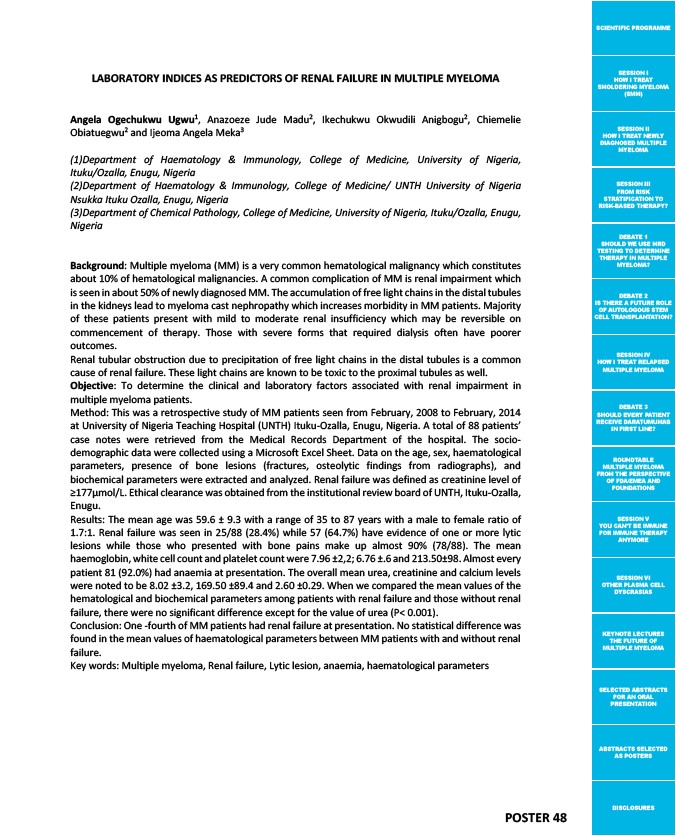
SCIENTIFIC PROGRAMME
SESSION I
HOW I TREAT
SMOLDERING MYELOMA
(SMM)
SESSION II
HOW I TREAT NEWLY
DIAGNOSED MULTIPLE
MYELOMA
SESSION III
FROM RISK
STRATIFICATION TO
RISK-BASED THERAPY?
DEBATE 1
SHOULD WE USE MRD
TESTING TO DETERMINE
THERAPY IN MULTIPLE
MYELOMA?
DEBATE 2
IS THERE A FUTURE ROLE
OF AUTOLOGOUS STEM
CELL TRANSPLANTATION?
SESSION IV
HOW I TREAT RELAPSED
MULTIPLE MYELOMA
DEBATE 3
SHOULD EVERY PATIENT
RECEIVE DARATUMUMAB
IN FIRST LINE?
ROUNDTABLE
MULTIPLE MYELOMA
FROM THE PERSPECTIVE
OF FDA/EMEA AND
FOUNDATIONS
SESSION V
YOU CAN’T BE IMMUNE
FOR IMMUNE THERAPY
ANYMORE
SESSION VI
OTHER PLASMA CELL
DYSCRASIAS
KEYNOTE LECTURES
THE FUTURE OF
MULTIPLE MYELOMA
SELECTED ABSTRACTS
FOR AN ORAL
PRESENTATION
ABSTRACTS SELECTED
AS POSTERS
DISCLOSURES POSTER 48
LABORATORY INDICES AS PREDICTORS OF RENAL FAILURE IN MULTIPLE MYELOMA
Angela Ogechukwu Ugwu1, Anazoeze Jude Madu2, Ikechukwu Okwudili Anigbogu2, Chiemelie
Obiatuegwu2 and Ijeoma Angela Meka3
(1)Department of Haematology & Immunology, College of Medicine, University of Nigeria,
Ituku/Ozalla, Enugu, Nigeria
(2)Department of Haematology & Immunology, College of Medicine/ UNTH University of Nigeria
Nsukka Ituku Ozalla, Enugu, Nigeria
(3)Department of Chemical Pathology, College of Medicine, University of Nigeria, Ituku/Ozalla, Enugu,
Nigeria
Background: Multiple myeloma (MM) is a very common hematological malignancy which constitutes
about 10% of hematological malignancies. A common complication of MM is renal impairment which
is seen in about 50% of newly diagnosed MM. The accumulation of free light chains in the distal tubules
in the kidneys lead to myeloma cast nephropathy which increases morbidity in MM patients. Majority
of these patients present with mild to moderate renal insufficiency which may be reversible on
commencement of therapy. Those with severe forms that required dialysis often have poorer
outcomes.
Renal tubular obstruction due to precipitation of free light chains in the distal tubules is a common
cause of renal failure. These light chains are known to be toxic to the proximal tubules as well.
Objective: To determine the clinical and laboratory factors associated with renal impairment in
multiple myeloma patients.
Method: This was a retrospective study of MM patients seen from February, 2008 to February, 2014
at University of Nigeria Teaching Hospital (UNTH) Ituku-Ozalla, Enugu, Nigeria. A total of 88 patients’
case notes were retrieved from the Medical Records Department of the hospital. The socio-demographic
data were collected using a Microsoft Excel Sheet. Data on the age, sex, haematological
parameters, presence of bone lesions (fractures, osteolytic findings from radiographs), and
biochemical parameters were extracted and analyzed. Renal failure was defined as creatinine level of
≥177μmol/L. Ethical clearance was obtained from the institutional review board of UNTH, Ituku-Ozalla,
Enugu.
Results: The mean age was 59.6 ± 9.3 with a range of 35 to 87 years with a male to female ratio of
1.7:1. Renal failure was seen in 25/88 (28.4%) while 57 (64.7%) have evidence of one or more lytic
lesions while those who presented with bone pains make up almost 90% (78/88). The mean
haemoglobin, white cell count and platelet count were 7.96 ±2,2; 6.76 ±.6 and 213.50±98. Almost every
patient 81 (92.0%) had anaemia at presentation. The overall mean urea, creatinine and calcium levels
were noted to be 8.02 ±3.2, 169.50 ±89.4 and 2.60 ±0.29. When we compared the mean values of the
hematological and biochemical parameters among patients with renal failure and those without renal
failure, there were no significant difference except for the value of urea (P< 0.001).
Conclusion: One -fourth of MM patients had renal failure at presentation. No statistical difference was
found in the mean values of haematological parameters between MM patients with and without renal
failure.
Key words: Multiple myeloma, Renal failure, Lytic lesion, anaemia, haematological parameters